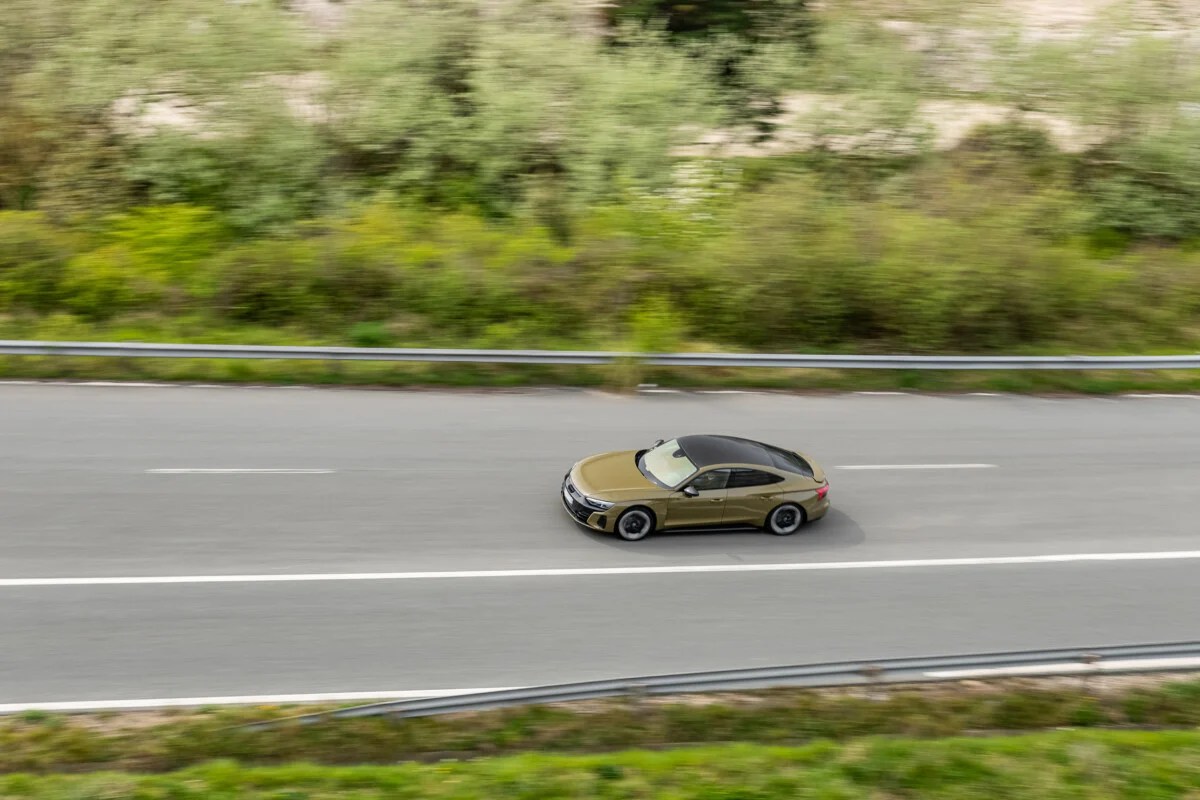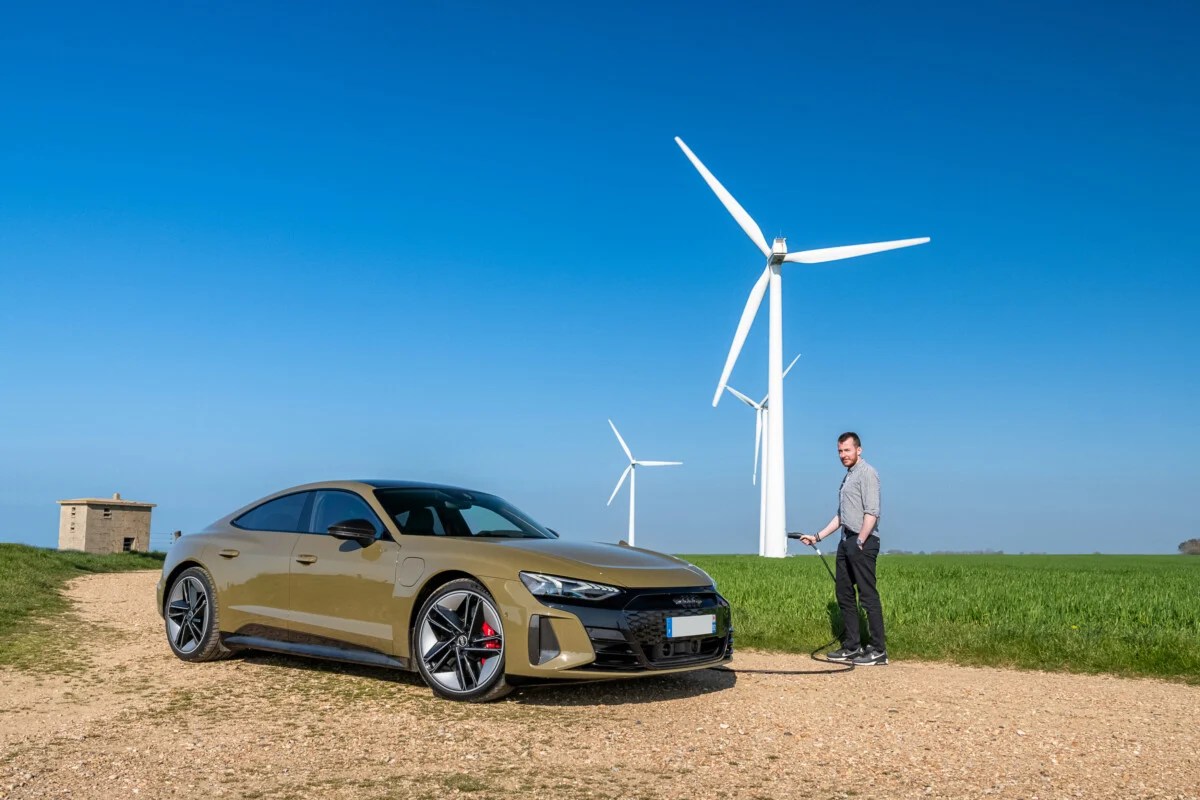After our test drive of the “small” 476 horsepower version, we got behind the wheel of the more powerful 598 horsepower version. If such a surge of power may seem quite useless today, the Audi RS e-tron GT does not encourage driving knife between the teeth.
In the category of electric and sports sedans, the models are not yet very numerous, but the segment has quickly filled up in recent years. If the Tesla Model S, even in its ultimate Plaid version, cannot be considered a real sports sedan, this is also the case for the Porsche Taycan and other Audi e-trons, its two main competitors. They are certainly more dynamic compared to the American sedan, but they nevertheless retain foolproof versatility with a high level of comfort.
On the Audi side, the electric and sporty sedan of the band is the RS e-tron GT. After our test of the “smallest” model, we took control of the most formidable, with almost 600 peak horsepower, performance almost similar to that of a Porsche Taycan Turbo S, all in a rather surprising comfort. Iron fist in a velvet glove, did you say?

Audi RS e-tron GTTechnical sheet
| Model | Audi e-tron GT (2021) |
|---|---|
| Category | sedans |
| Power (horses) | 476 horsepower |
| Power (kw) | 350kW |
| 0 to 100 km/h | 4.1 seconds |
| Level of autonomy | 5 |
| Max speed | 245 km/h |
| Apple CarPlay | Yes |
| Android-Auto | Yes |
| Main screen size | 12.3 inches |
| Car side sockets | Type 2 Combo (CCS) |
| Length | 4990mm |
| Width | 1960mm |
| Entry-level price | 99800 euro |
Product sheet See the test |
Audi RS e-tron GTDesign
Contrary to what one might think, the Audi RS e-tron GT is a large car, very large even, since it is close to 5 meters long and almost 2 meters wide. The e-tron GT is Audi’s second electric model and stems from the concept car eponym presented at the Los Angeles show in 2019.
The production version uses almost the same lines as the concept, for a spectacular final rendering. If, aesthetically, the affiliation with the Porsche Taycan is not obvious, technically, it is, with a few details, the same two cars.
Habitability
On board, the Audi RS e-tron GT may be 5 meters long, but it is not really a reference in terms of space. In the front seats, we feel a little too cramped, with a fairly prominent center console that reduces the space on board.

In the back, the seats are very cramped and the headroom is just right for an adult. Knee space is moderately acceptable for such a large car. Regarding the trunk, it offers a capacity of 405 liters, which is not bad in itself for an electric car, but the second trunk of 81 liters at the front will probably not be too much.


Audi RS e-tron GTEmbedded technologies
Technically similar to the Porsche Taycan, the cabin is quite different. If the Taycan wants to be more refined, in particular thanks to the presence of three screens (or even four), the passenger compartment of the Audi e-tron GT has two touch screens and some physical controls.
Ergonomics are generally very good and the shortcut keys like an airplane cockpit are excellent complements to the touch screen. The screen benefits from neat graphics and rather well-ordered menus, as usual with the brand with the rings. It brings together the entire infotainment system and controls relating to the use and energy of the car. Of course, the set is compatible with Apple CarPlay and Android Auto.


Audi RS e-tron GTConduct
At the first kilometers covered, the difference with an e-tron GT quattro, its little sister, is clearly not obvious. Looking like a senator, the e-tron is aptly named GT, with a fairly remarkable smooth ride and damping adjusted to small onions. It’s comfortable, even in the rear seats, and the roughness of the road is smoothed out by a well-tuned controlled suspension.
With an RS badge of course, it is rather the sporty aspect that will interest us. And overall, as with the small GT quattro version, the RS e-tron GT is a notch below the Porsche Taycan Turbo in terms of dynamism. Our model retains a fairly pleasant degree of comfort, even in “Dynamic” mode with 600 horsepower under the right foot. The Taycan Turbo is still a notch above in terms of driving sensations at a sustained pace, the Audi preferring to have it both ways and not sacrificing comfort on the altar of sportiness.

On the other hand, the speed settings have nothing of those of a comfortable car. When you press the right pedal, the firing is impressive. Acceleration from 0 to 100 km/h takes 3.3 seconds, the time of the best supercars on the market.
When the Taycan is riveted to the ground, the RS e-tron GT is paradoxically a little more playful, even if the Michelin Pilot Sport 4S tires provide better grip than the Goodyear tires we had during our first test more than a year ago. ‘a year. Something to be a little more reassured on wet surfaces.
The Audi is less incisive of the front axle, but embarks more readily from the rear axle. The e-quattro all-wheel drive allows distribution of up to 100% of the torque at the rear axle only, which also greatly facilitates this little oversteer side.
Then there is another phenomenon to take into account on this type of car, it is inertia. And despite all the technological paraphernalia that equips our Audi (steering rear wheels, Sport controlled differential at the rear, etc.), the 2,347 kilos when empty of our test model are not to be overlooked.

Audi RS e-tron GTAutonomy, battery and charging
The Audi RS e-tron GT quattro has two electric motors; one fixed at the front axle and the other on the rear axle. It develops 598 horsepower (646 horsepower with Overboost) and 830 Nm of torque. The 0 to 100 km/h is announced in 3.3 seconds and the maximum speed at 250 km/h.
The powertrain is the same as on board a Porsche Taycan, only the power management is modified. The Audi RS e-tron GT has a two-speed gearbox, allowing you to have power all the time, even at unmentionable speeds. These two gears are based on three drive shafts, while the rear axle also has a controllable differential lock.

Audi announces a recharge from 5 to 80% in 22.5 minutes with the maximum power of 270 kW. It will take about nine hours on an 11 kW alternating current outlet to go from 0 to 100% and around thirty hours on a traditional power outlet.
On the battery side, the car relies on an 800-volt architecture, not 400, which allows for a more consistent distribution of performance. The battery contains 33 modules, themselves made up of 12 cells, i.e. 396 cells in total, with a total capacity of up to 93.4 kWh (including 86 useful kWh). Each module has an internal control unit to manage voltage and temperature. This is integrated into the cooling circuit via a heat pump, the battery can thus be cooled or heated in order to be perpetually within an adequate temperature window.
As for autonomy, Audi announces 472 km with a single charge. Overall, this is a data that can be held in general-purpose use, the car not having much appetite for 600 hp and 2.3 tons on the scale. It must be said that its excellent Cx (the drag coefficient) of 0.24 allows you to glean a few precious kilometers compared to SUVs and their cinderblock aerodynamics.
Over our 700 km test, we noted an average of 23.5 kWh / 100 km, with use not really representative of daily driving. Between sporty driving on small departmental roads and highways over 400 km, we thought that its consumption was going to soar, but it remains generally good for a car of this size. In casting driving, we managed to go below 18 kWh / 100 km. On the highway, at 130 km/h and with all the comfort systems activated, the Audi RS e-tron GT can travel around 330 km with a charge, given what the on-board computer told us.

Audi RS e-tron GTPrice
The Audi RS e-tron GT is available from 140,700 euros, almost 40,000 euros more than the base price of the e-tron GT quattro. Certainly, the equipment endowment is not the same, but the “small” version does not deserve in terms of performance with a 0 to 100 km / h in 4.1 seconds.
Hierarchy obliges, the Porsche Taycan Turbo is more expensive and is negotiated from 156,334 euros, without option. On the other side of the Atlantic, there is the Tesla Model S Plaid which promises hair-raising performance at an almost “gift” price. The 0 to 100 km/h is announced in 2.1 seconds, the top speed at 322 km/h and the price is 119,990 euros.
Photos: Marius Hanin
